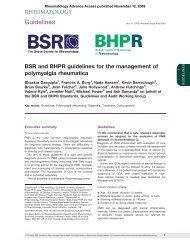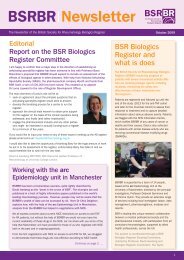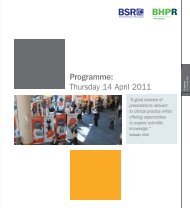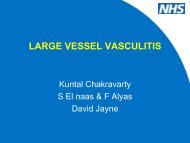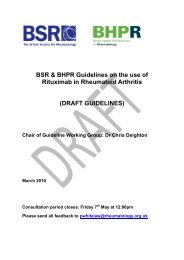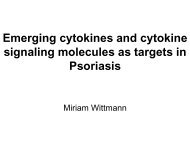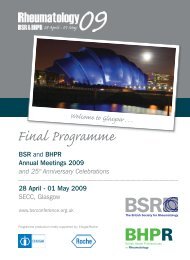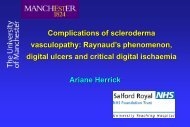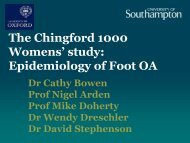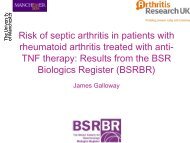Guidelines for the treatment of psoriatic arthritis with biologics
Guidelines for the treatment of psoriatic arthritis with biologics
Guidelines for the treatment of psoriatic arthritis with biologics
Create successful ePaper yourself
Turn your PDF publications into a flip-book with our unique Google optimized e-Paper software.
<strong>with</strong> 3mg/kg abatacept. Improvement was also seen in target lesion score <strong>of</strong> psoriasis and magnetic<br />
resonance imaging (MRI) assessment <strong>of</strong> synovitis. Disappointingly, results were not as good in those patients<br />
who had previously failed an anti‐TNF drug (ACR20 31% vs 56%) [106].<br />
Apremilast<br />
Apremilast is an oral phosphodiesterase‐4 inhibitor which has been tested in psoriasis and PsA. A phase II<br />
study <strong>of</strong> 204 patients found a modest effect in <strong>arthritis</strong> <strong>treatment</strong> <strong>with</strong> a significant difference in ACR20 <strong>for</strong><br />
both 20mg bd and 40mg od doses. A significant difference was not seen in ACR70 <strong>with</strong> very few patients<br />
achieving such a marked improvement in disease activity [107].<br />
TNF antagonist gene <strong>the</strong>rapy<br />
One study to date has highlighted <strong>the</strong> use <strong>of</strong> rAAV2‐TNFR:Fc, a recombinant adeno‐associated viral vector<br />
containing <strong>the</strong> human TNF receptor‐immunoglobulin (IgG1) Fc fusion (TNFR:Fc) gene. The study was a blinded<br />
study <strong>with</strong> patients <strong>with</strong> inflammatory <strong>arthritis</strong> including PsA randomised to receive intra‐articular injections <strong>of</strong><br />
escalating dose concentrations <strong>of</strong> <strong>the</strong> gene or placebo at a ratio <strong>of</strong> 3:1. Injection site reactions occurred in 14%<br />
<strong>of</strong> cases and were dose‐dependant. Only one case <strong>of</strong> septic <strong>arthritis</strong> occurred but was felt to be unrelated to<br />
<strong>the</strong> gene <strong>the</strong>rapy. There was a reduction in patient reported global visual analogue scores (VAS) <strong>for</strong> <strong>the</strong> target<br />
joint but this was not significant when compared to placebo [108].<br />
Auditing Potential Impact <strong>of</strong> <strong>the</strong> <strong>Guidelines</strong><br />
An audit was undertaken at <strong>the</strong> Royal National Hospital <strong>for</strong> Rheumatic Diseases in Bath, to assess <strong>the</strong> potential<br />
impact <strong>of</strong> changing <strong>the</strong> eligibility criteria from those in <strong>the</strong> 2005 BSR guidelines. The old (2005) and proposed<br />
new (2012) eligibility criteria were applied to 100 PsA patients. Cases were selected sequentially from three<br />
months <strong>of</strong> clinics between September and December 2011 from <strong>the</strong> hospital’s longitudinal PsA cohort. Only<br />
patients who had been on at least one DMARD in <strong>the</strong> past were included. Case notes were reviewed over <strong>the</strong><br />
prior 5 years to avoid calendar bias. In 66 cases (2/3rd) <strong>the</strong> new guidelines would not have resulted in any<br />
change to management over <strong>the</strong> last 5 years. In 21 cases (1/5th) <strong>the</strong> new guidelines would have resulted in an<br />
opportunity to commence an anti‐TNF drug not possible under <strong>the</strong> old guidelines. 12 patients were on anti‐<br />
TNF <strong>for</strong> joint disease and in 10 cases <strong>the</strong>y would have been eligible <strong>for</strong> anti‐TNF <strong>the</strong>rapy at an earlier time<br />
point (mean 32 months). The lower eligibility criteria proposed in <strong>the</strong>se guidelines will <strong>the</strong>re<strong>for</strong>e result in an<br />
opportunity to commence anti‐TNF at an earlier stage and <strong>the</strong> audit provides evidence that this may increase<br />
<strong>the</strong> number <strong>of</strong> people on anti‐TNF in a secondary care cohort.<br />
AGREE instrument evaluation<br />
The AGREE instrument was used to assess and evaluate <strong>the</strong>se guidelines by four independent reviewers<br />
including rheumatologists and dermatologists <strong>with</strong> a special interest in psoriasis and PsA. Results <strong>for</strong> each <strong>of</strong><br />
<strong>the</strong> six domains <strong>with</strong>in <strong>the</strong> AGREE instrument (scope and purpose, stakeholder involvement, rigour <strong>of</strong><br />
development, clarity and presentation, applicability, editorial independence) are presented in table shown on<br />
p30.<br />
Audit Tools<br />
An audit pro<strong>for</strong>ma to assess compliance <strong>with</strong> <strong>the</strong>se guidelines is available pages 28 and 29.<br />
17




